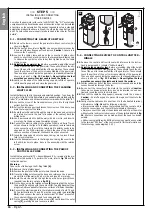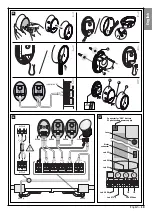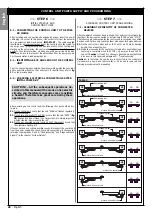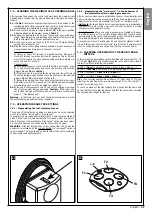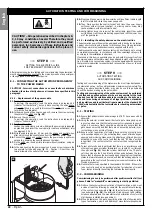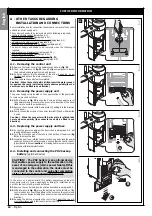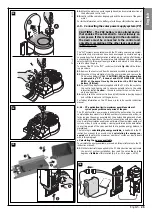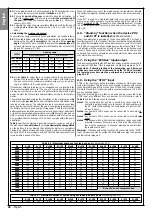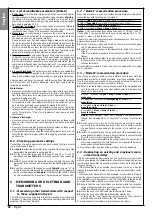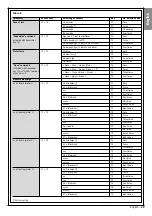
02.
On the graphs (North or South) supplied in the PF kit instruction man-
ual, locate the curve for the location’s
latitude
(
e.g: 45°N)
.
03.
Choose the
period of the year
on which to base the calculation, or
select the lowest point of the curve to calculate
the worst period of
the year;
then read the corresponding value
Am
(e.g. December,
January: Am= 200)
.
04.
Calculate the value of energy available
Ed
(produced by the panel)
multiplying
Ea
x
Am
=
Ed
(example: Ea = 14; Am = 200, i.e. Ed =
2800)
.
• Calculating the energy consumed
To calculate the energy consumed by the automation, proceed as follows:
05.
On the table below, select the box corresponding to the intersection
between the line with the
weight
and the column with the
opening
angle
of the leaf. The box contains the value of the
severity index
(K)
for each manoeuvre
(
e.g.
gearmotor with standard arm on leaf of 130
Kg and 95° opening; K = 84)
.
06.
On the
table 4,
select the box corresponding to the intersection
between the line with the
Ed
value and the column with the
K
value.
The box contains the maximum possible number of cycles per day
(e.g.
Ed= 2800; K= 84; cycles per day = 30)
.
If the number obtained is too low for the envisaged use or is located in the
“area not recommended for use”, the use of 2 or more photovoltaic pan-
els may be considered, or the use of a photovoltaic panel with a higher
power. Contact the Mhouse technical assistance service for further infor-
mation.
The method described enables the calculation of the maximum possible
number of cycles
per day
that can be completed by the automation while
running on solar power. The calculated value is considered an average
value and the same for all days of the week. Considering the presence of
the battery, which acts as an energy “storage depot”, and the fact that the
battery enables automation autonomy also for long periods of bad weath-
er (when the photovoltaic panel produces very little energy) it may be pos-
sible to exceed the calculated maximum possible number of cycles per
day, provided that the average of 10-15 days remains within the envis-
aged limits.
Table 5
specifies the maximum possible number of cycles, according to
the manoeuvre’s
severity index
(K), using
exclusively the energy stored
by the battery. It is considered that initially the battery is completely
charged (e.g. after a prolonged period of good weather or recharging via
the optional PCB power supply unit) and that the manoeuvres are per-
formed within a period of 30 days.
When the battery runs out of the stored energy, the led starts to indicate
the battery low signal by flashing briefly every 5 seconds, accompanied by
a “beep”.
If the “WT” is used on a single leaf gate (with only one gearmotor), the
maximum possible number of cycles corresponds to the value in the
tables, multiplied by
1.5.
For example, if the calculated number of cycles
is 30 and the gate has one leaf only, the number of cycles will be: 30 x
1,5
= 45.
A.6 - “Stand-by” function when the device PR2
and/or PF is installed
(optional devices)
When the automation is powered by the backup battery PR2 or the pho-
tovoltaic system PF, the “standby” function is activated automatically 60
seconds after completion of an automatic manoeuvre cycle. This turns off
the “ECSbus” output and all connected devices, the outputs “Flash”, “Els”
and all leds, with the exception of the ECSbus led which flashes more
slowly (1 flash every 5 seconds). After this, as soon as the user sends a
command, the control unit restores power and starts the manoeuvre
(this
may start with a short delay).
A.7 - Using the “ECSBus” input/output
Only devices compatible with ESCBus technology must be connected to
the terminal “ESCBus” (this is explained in detail in paragraph 3.3.3).
Important
– Following testing of the automation, each time new
devices are connected to (or removed from) the “ECSBus” terminal,
the learning procedure must be performed as described in para-
graph A.10.
A.8 - Using the “STOP” input
STOP is the input that causes immediate shutdown of the manoeuvre
(with brief inversion). This input can be connected to devices with contact
types Normally Open (NO, as in the case of the KS100 selector switch),
Normally Closed (NC) or devices with a constant resistance of 8.2 K
Ω
,
such as sensitive edges.
When set accordingly, more than one device can be connected to the
STOP input, also different from one another. For this function, refer to
Table 6
and the following notes to the table.
Note 1.
The combination NO and NC is possible by connecting the 2
contacts in parallel, taking care to connect a 8.2k
Ω
resistance to
the NC contact (this enabling the combination of 3 devices: NO,
NC and 8,2k
Ω
).
Note 2.
Any number of NO devices can be connected to each other in
parallel.
Note 3.
Any number of NC devices can be connected to each other in
series.
Note 4.
Two devices with a 8,2k
Ω
constant resistance can be connected
in parallel. However if there are more than two of these devices,
they must be connected “in cascade” placing only one terminat-
ing resistance of 8,2k
Ω
.
Warning!
– If devices with safety functions are connected to the “STOP”
input, only devices with a constant 8,2k
Ω
resistance output can guaran-
tee fault safety category 3.
TABLE 4 - Maximum number of cycles per day
(see paragraph A.5.1)
Ed
K
≤
50
K
≤
75
K=100
K=125
K=150
K=175
K=200
K=225
K=250
K=275
K=300
9500
183
122
92
73
61
52
46
41
37
33
31
9000
173
115
87
69
58
49
43
38
35
31
29
8500
163
109
82
65
54
47
41
36
33
30
27
8000
153
102
77
61
51
44
38
34
31
28
2
7500
143
95
72
57
48
41
36
32
29
26
24
7000
133
89
67
53
44
38
33
30
27
24
22
6500
123
82
62
49
41
35
31
27
25
22
21
6000
113
75
57
45
38
32
28
25
23
21
19
5500
103
69
52
41
34
29
26
23
21
19
17
5000
93
62
47
37
31
27
23
21
19
17
16
4500
83
55
42
33
28
24
21
18
17
15
14
4000
73
49
37
29
24
21
18
16
15
13
12
3500
63
42
32
25
21
18
16
14
13
11
11
3000
53
35
27
21
18
15
13
12
11
10
9
2500
43
29
22
17
14
12
11
10
9
8
7
2000
33
22
17
13
11
9
8
7
7
6
6
1500
23
15
12
9
8
7
6
1000
13
9
7
Area of use not recommended
TABLE 5 - Maximum number of cycles using exclusively battery power
(see paragraph A.5.1)
K
≤
50
K
≤
75
K=100
K=125
K=150
K=175
K=200
K=225
K=250
K=275
K=300
1082
721
541
433
361
309
271
240
216
197
180
Opening angle
with standard arm with short arm
Leaf weight
≤
90°
90÷100° 100÷110°
≤
90°
90÷100° 100÷110°
< 80 Kg
30
44
60
60
84
112
80-120 Kg
42
58
90
90
128
200
120-150 Kg
55
84
144
144
220
288
150-180 Kg
86
126
220
motor
English
26
– English
Summary of Contents for WT1S
Page 11: ...1 2 3 4 45 3 1 2 a c b OK b a a b c d b a 5 6 7 8 9 10 11 12 13 13 English 10 English...
Page 14: ...OK b a 1 2 17 AA ok BB no OK 18 1 2 16 3 4 2 1 English English 13...
Page 15: ...b a 1 2 3 4 5 6 20 a b 1 2 3 4 19 English 14 English...
Page 36: ...Technical Documentation English English 35...
Page 37: ...English 36 English...
Page 39: ...English 38...
Page 41: ...English 40 English...
Page 44: ...Goniometer English English 43...
Page 45: ...44 English English Goniometer...





